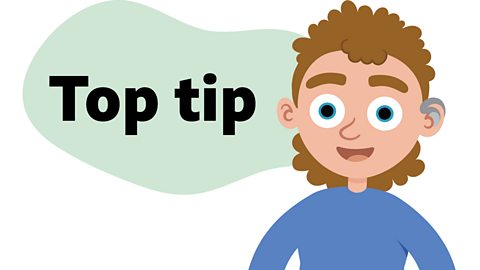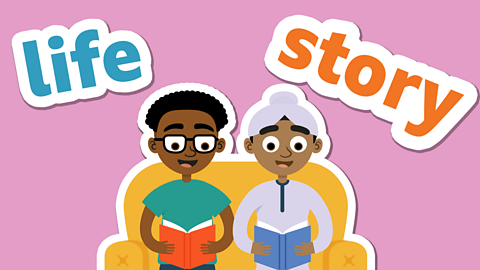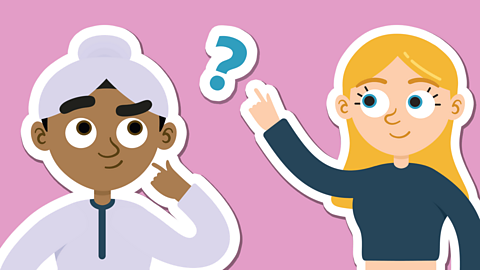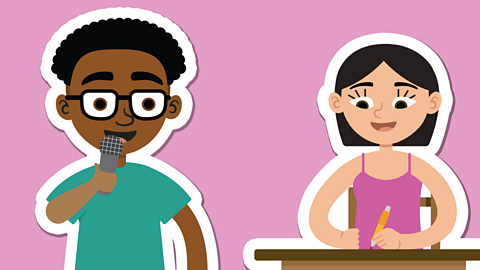Watch: How to give a presentation
Presentations can be used to convince or persuade people, or to just give them information.
Watch this video to learn some top tips about making and giving presentations.
Top tips on how to give a presentation.
How to give a presentation.
Presentations can be used to convince or persuade people or just to give them information.
The key to any good presentation is preparation. Planning your talk is crucial.
Prepare your points, slides and props in advance, so that your message is clear.
It is important to know who your audience is as this will inform the design of your presentation.
Oh, vampires, that explains a lot.
My goodness. That is a lot of text. Try and make your introduction shorter and punchier.
Play about with your design to find something that will appeal to your audience. That's better.
But let's not go too far, avoid unnecessary transitions as they can be distracting.
You might want to use graphs, charts or quotes to support your ideas. Or maybe you have some research to support your points.
And that's a good, strong message to end on. I think he's ready.
His body language looks confident, doesn't it?
He's making eye contact with the audience. That is good, good delivery of the opening message.
Remember to project your voice. Speak clearly.
SIGHS
This is a tough audience.
Don't rush. Your audience need time to read your slides so only put up key points, not everything you're going to say.
Try not to turn your back on the audience or read from the screen.
At the end, repeat the main points and round off with something memorable.
Very good indeed. A splendid job.
And you should always thank your audience at the end and ask if they have any questions.
They like it. Hooray!
But quite frankly, I think anyone interested in Red Fang has to be a bit batty. Told you so.
Making a presentation
- Planning
Preparation is key. Organising the key points, visuals (slides, handouts, props etc) is important so you can use them to make your message clear.
- Audience
Think about who your audience is. This will help you to design your presentation and choose the right tone.
- Reduce text
Don’t include too much detail, just key ideas and important information. Make your writing punchy, appealing and to the point.
- Safe and simple
Don’t overcomplicate your presentation with stunts, transitions and gimmicks – these can be distracting.
- Charts, graphs and quotes
You may use a quote from someone who has experience of your idea or product.
- Clear message
Make the key point at the start and end.

Top tips for giving a presentation:
- Body language and eye contact
Open body language, face your audience and make eye contact.
- Speak clearly
Project your voice so that everyone can hear you well.
- Don’t rush
Give the audience time to look at your visuals (pictures, slides, graphs etc).

Watch: Using maps and charts

Maps, charts and graphs are very useful for presenting complicated information in a visual way that is easier to understand.
Maps show the location of different places, objects or people. They use:
a key (to help you to understand what different symbols on the map mean)
a scale (to help you to work out the distance between thing)
Graphs show results. Remember to include a title, axis labels and accurately plotted information so it makes sense to the reader.
Charts are to represent information (data), such as how many medals were won at the Monster Games and by who.
Watch this video to learn some top tips about giving an effective, interesting presentation.

Learn when to introduce maps, charts or graphs into your writing.
How to use maps, charts and graphs in writing.
Graphs, charts and maps are very useful for presenting complicated information in a visual way that is easier to understand.
Imagine that we are putting together some details for the live online programme about the Monster Games.
Let's look at where all of the different events are taking place.
That's a lot of information to take in. How about we use a map instead?
This way we can sure where all the events are taking place using a key like this.
We can see how far away everything is using the scale.
There, that's much easier to understand now.
Where is the one hundred metre race taking place?
Ah yes, in the Ghastly Garden. Right, that will be a good one to watch.
Just in time and they're off.
Well, that's an unusual way to win a race. Lets look at the results.
We can see the Mummy came first, but by how much?
If we use a bar graph, we can see this information much more clearly.
We will put the runners along the X axis along the bottom and the time up the Y axis up the side.
Each runner's time is then represented by a bar in the graph.
You should label your graph so that it is easy for your reader to see what they are looking at. There, that's better.
Just look how quick the Mummy was or at least his arm.
I wonder how many medals each monster has won?
A pie chart is a good way to show this clearly.
Each section of the pie chart represents how many medals each monster has won as a portion of the total number of medals.
The bigger the piece of pie, the more medals they have won.
Remember to give your chart a title. Much better.
My goodness, the Mummy has been doing very well at these games, hasn't he? Especially considering he's been dead for two thousand years.
But those two don't look very pleased with him.
Oh, there are some things that we don't need to see any more graphically. Thank you very much.
Activity 1
Give this quiz on giving an effective presentation a try.
Activity 2
Pocket Money Pitch
Watch this video in which TV presenter Steph McGovern explains the ‘Pocket Money Pitch’ challenge. A pitch is a presentation where the aim is to persuade your audience to invest in a product you have designed.
Find out about the 'Pocket Money Pitch' challenge.
Now watch the first 30 seconds of this clip.
What does Sarah Jane Thompson say was so good about Daniel's presentation? List two things.
Find out what makes a great pitch.
Think of a product that you would love to make and sell. This can be realistic or totally made up - it’s up to you!
Imagine you are presenting your own idea on ‘Pocket Money Pitch'.
Write a two-minute presentation for your product.
Think carefully about the information you need to include.
Use the presentation top tips to help make your presentation a success.
Other examples
Looking for inspiration? Have a look at this pitch for ideas.
Super challenge
Can you include graphs, charts or quotes in your product presentation?
Play Crystal Explorers to get ready for SATs. gamePlay Crystal Explorers to get ready for SATs
In this game, use grammar, punctuation and spelling skills to explore jungles, caves and tombs on your mission!

More on Non-fiction
Find out more by working through a topic
- count12 of 18

- count13 of 18

- count14 of 18

- count15 of 18
